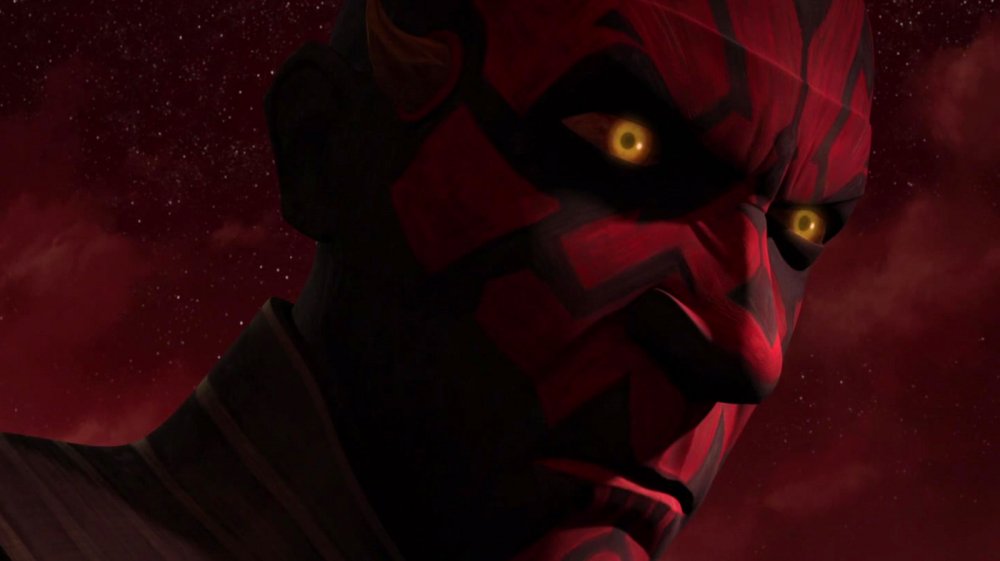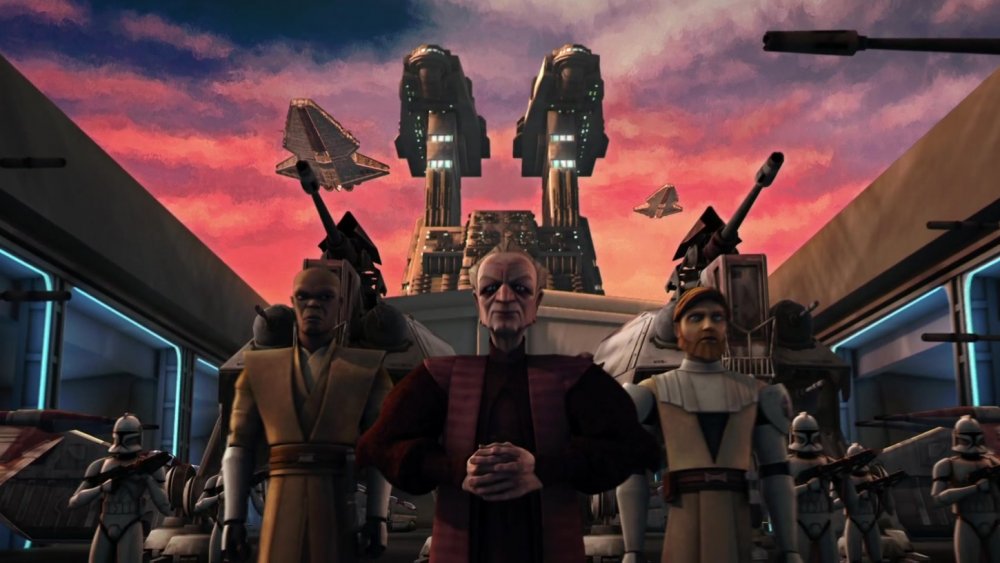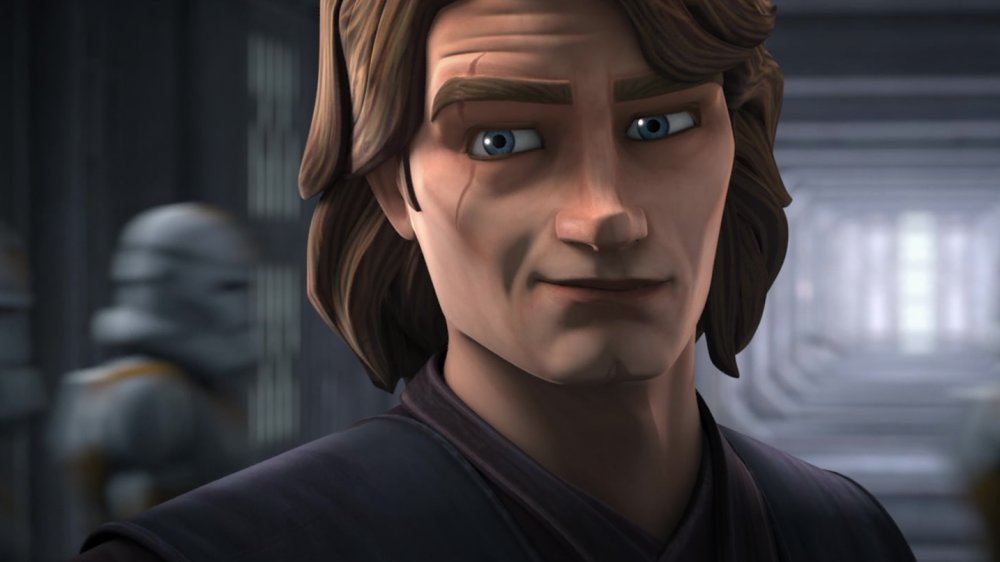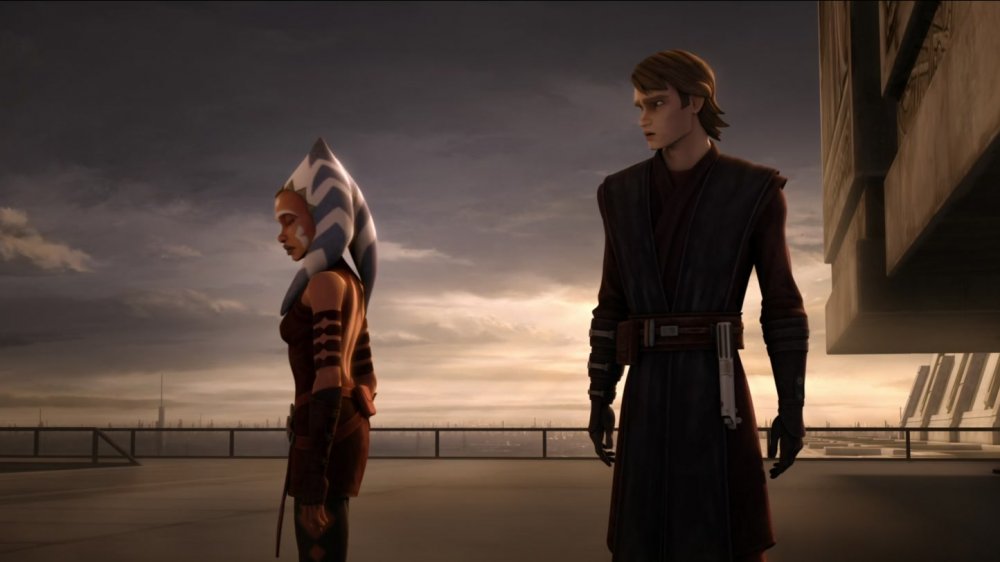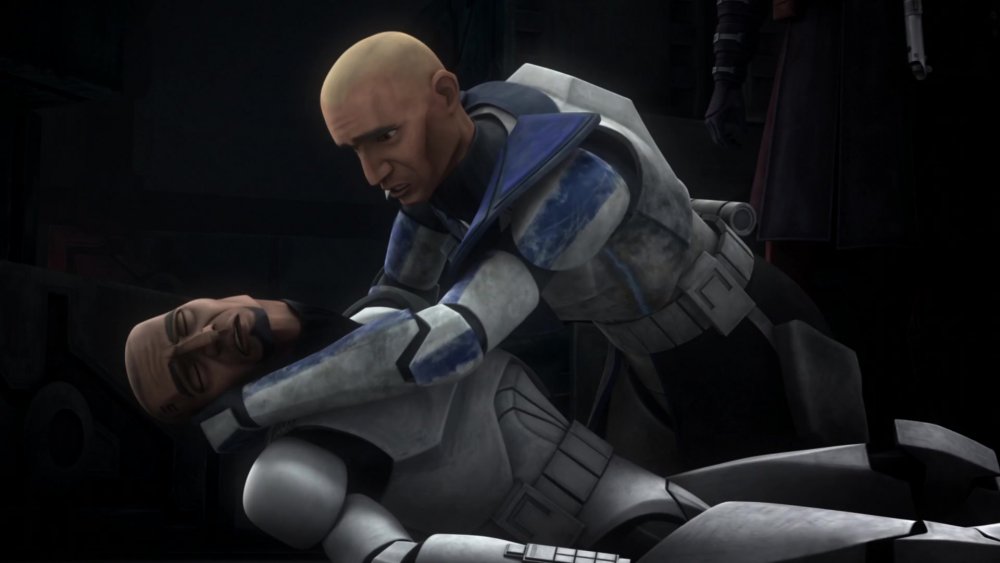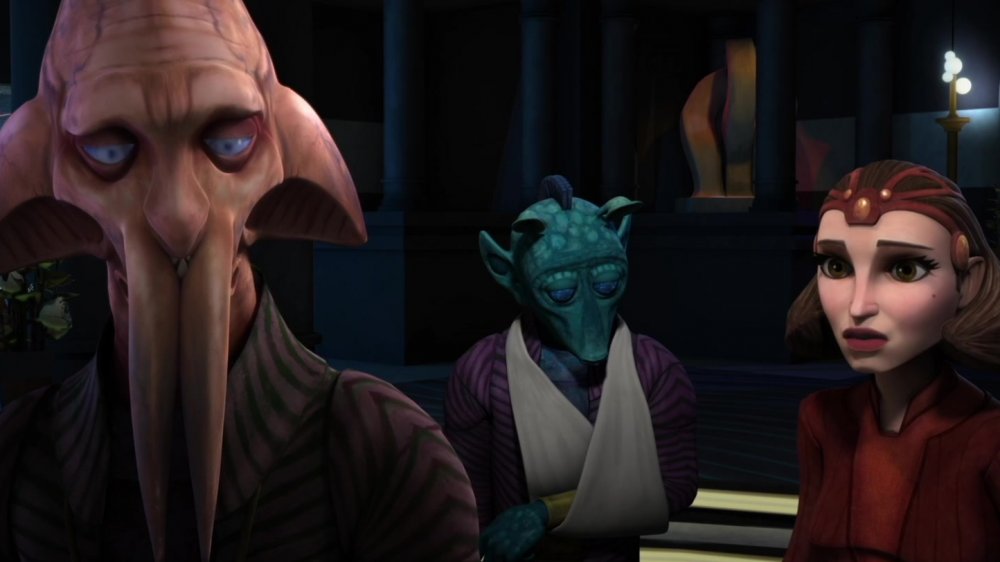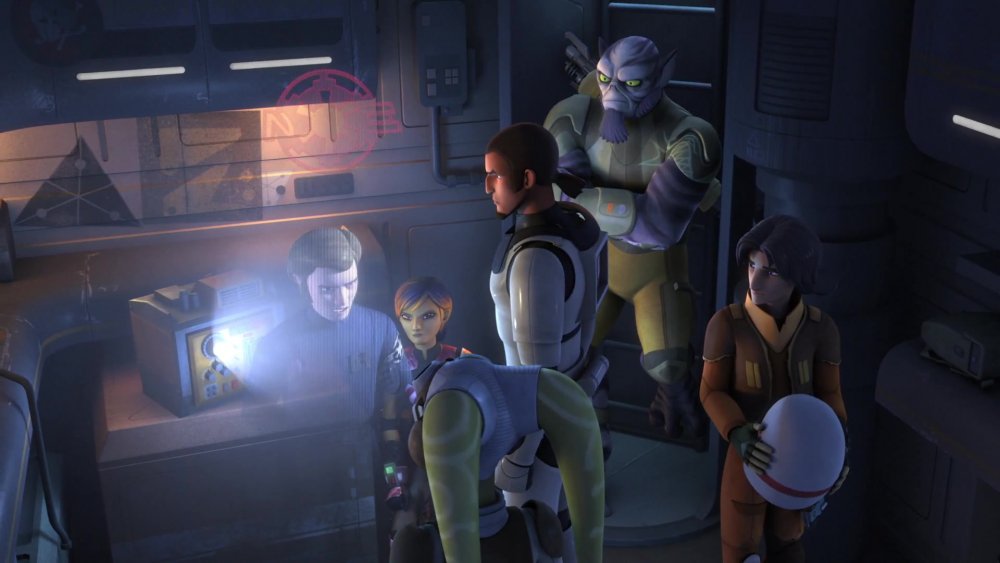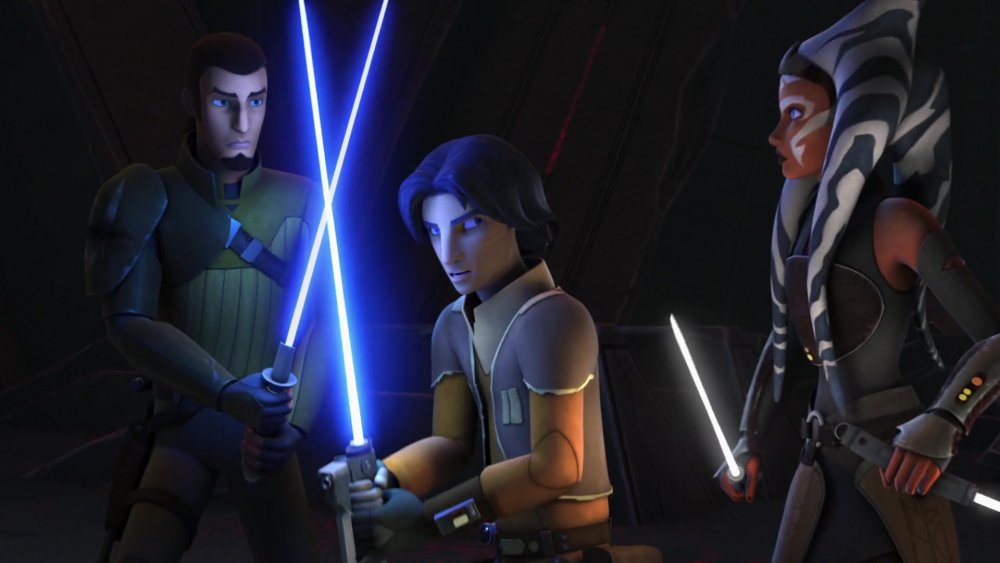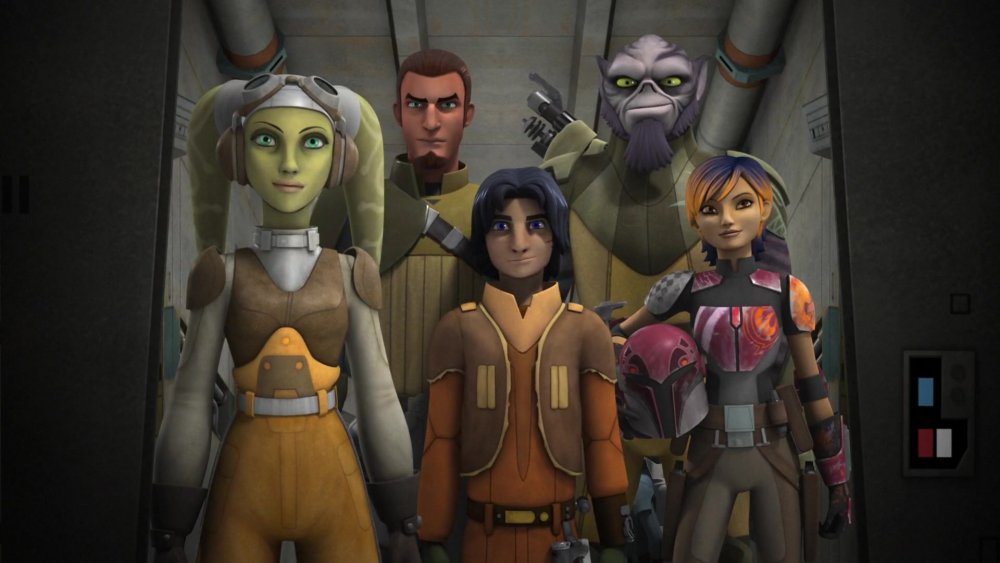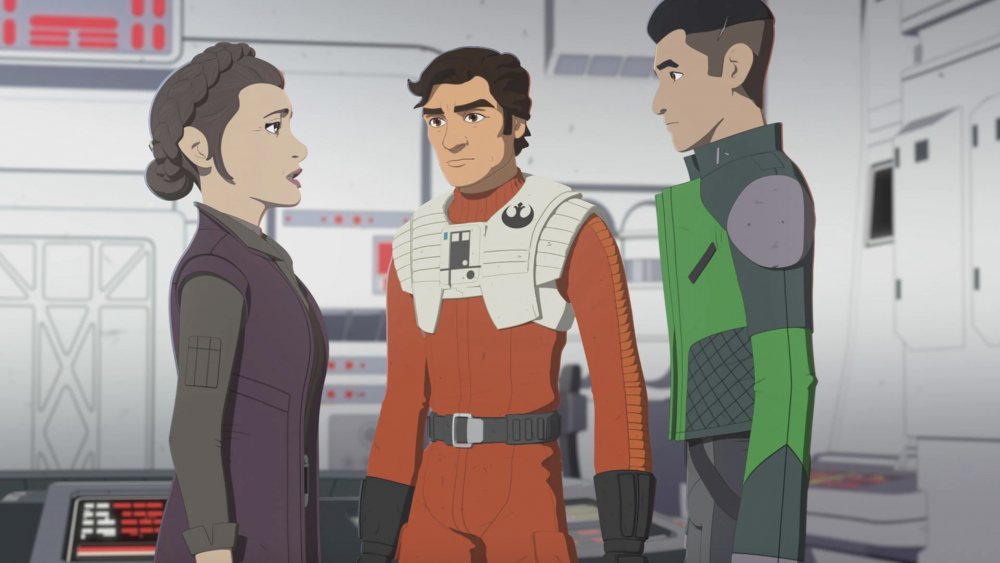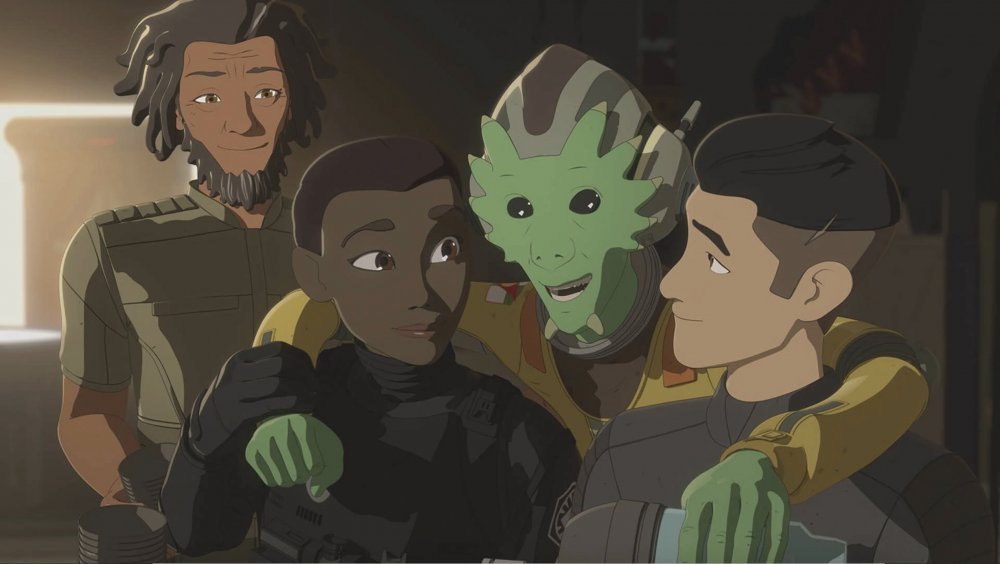Things Only Adults Notice In The Star Wars Animated Series
Star Wars is a sprawling multimedia franchise that manages to appeal to just about everyone. The films entertain all ages, there are books for even the youngest readers, and video games exist for casual and hardcore fans alike. And then, of course, there are the animated series.
Sure, these shows are aimed at kids who put plastic lightsabers on their holiday wish lists. But while they may appeal to children, make no mistake — these aren't toy commercials. These series are produced by adults who want to tell interesting stories. Each series expands on a particular era of the existing Star Wars mythology, fleshing out the universe to wonderful effect. Star Wars: The Clone Wars fills the gap between Attack of the Clones and Revenge of the Sith, alternating between fairly simple action-adventure and staggeringly dark military drama. Star Wars Rebels is an emotional story set in the years just before the original Star Wars, chronicling the birth of the Rebel Alliance from the perspective of one close-knit surrogate family. Star Wars Resistance overlaps with the sequel trilogy, using a lighter tone to tell the story of a group of competitive racers who rise up to fight the First Order.
These shows certainly sell their share of 1:8-scale starfighters, but they also offer plenty of cool ideas for grown-up fans to play with. We're here to explore the adult aspects of these animated series.
The Clone Wars are about nothing
In Attack of the Clones, a massive war breaks out between the Galactic Republic and a separatist group, the Confederacy of Independent Systems, over ... something. The films never make it very clear what these factions think they're fighting for — it's enough that the protagonists are fighting for one side and put in jeopardy by the treacherous actions of the other. By the time the true purpose of the war is revealed in Revenge of the Sith, all but the youngest viewers have already worked out the barely-concealed truth: Chancellor Palpatine and Darth Sidious are one and the same, commanding both factions in order to garner more power, so that he can reform the Republic into his own Galactic Empire.
The Clone Wars greatly expands on the grander political ramifications of this conflict, and clarifies it into a clear, definitive statement: The Clone Wars really are about nothing. The Confederacy and the Republic have legitimate grievances with each other, but the war itself is engineered by Palpatine and a conspiracy of corporations who stand to gain more from endless fighting and chaos than they do from either side winning. Once the fighting starts, the Techno Union, the Banking Clan, and the Dark Lord of the Sith can count on it continuing indefinitely, because nationalism is powerful ... and they intend to profit.
Anakin Skwalker could've been cool
In the original Star Wars trilogy, Jedi Master Obi-Wan Kenobi speaks fondly of his good friend Anakin Skywalker, a fellow Jedi with whom he served in the Clone Wars. When he finally explains the truth of Anakin's fall from grace to Anakin's son, Luke, Obi-Wan paints a picture of a good-hearted man tragically corrupted into a monster. But when the audience gets to meet young Anakin for themselves in the prequel trilogy, he's such a hotheaded, mass-murdering creep that even a viewer who's not in on the dramatic irony of the story can easily point him out as a ticking time bomb.
Only in The Clone Wars do we get to spend time with a version of Anakin Skywalker who lives up to his reputation as a hero and a friend. Unlike his movie counterpart, whose behavior seems driven entirely by selfishness, there's a warmth to Clone Wars Anakin. When thrust into the role of mentor to padawan Ahsoka Tano, Anakin learns real wisdom and patience — one can even imagine he might have actually made a decent parent to Luke and Leia in these moments. Watching Clone Wars between Attack of the Clones and Revenge of the Sith gives Anakin's betrayal real weight, since the animated version of the character is a guy who the audience might actually miss.
Nobody likes the Jedi
For decades, the Jedi Knights that Obi-Wan Kenobi and Yoda speak of in the original trilogy are unseen, left to the viewer to imagine and idealize. The prequel trilogy gives audiences a firsthand look at the Jedi Order, and they're revealed to be ... a weird, repressed cult sowing the seeds of their own doom. The Clone Wars takes a longer, harder look at the galaxy's self-described defenders of peace and justice, and reveals just how many people across the galaxy hate their guts.
Naturally, certified baddies like the Sith and General Grievous are expected to loathe the Jedi Order, but the Jedi have provoked the ire of plenty of other, less obvious factions. The Mandalorian faction Death Watch still considers the Jedi their mortal enemy after centuries of conflict. The Dagoyan Masters abhor the Jedi for their practice of taking young, Force-sensitive children away from their parents to be indoctrinated into the Order. The Jedi receive criticism from those they serve, and from those they serve with. Citizens assemble outside the Jedi Temple in protest of the war in which they serve as military leadership. Errant clone trooper Slick defects against the Jedi for "enslaving" the clones, an act in which they are unquestionably complicit. Even Ahsoka Tano turns away from the Order after learning what it feels like to be on their bad side. It seems the more you get to know the Jedi, the less you like them.
The Clone Army is the Republic's greatest sin
When Attack of the Clones was first released in 2002, the concept of the Clone Wars being fought by two faceless, expendable fighting forces felt like it was motivated more by the desire to sell toys than to tell a story. Populating these massive battle scenes with apparently soulless automatons makes these war films more palatable to children buying action figures and the parents who pay for them, after all. But The Clone Wars makes the most of this set-up, reframing the clones themselves as the war's greatest victims.
The clones may have been bred and brainwashed for war, but as the series demonstrates by their nuanced portrayals, they're still human beings. Over time, they deviate from their base programming to become individuals like Captain Rex, Commander Cody, troopers Echo and Fives, and the Bad Batch. They have feelings, form friendships with the Jedi, and love their fellow clones as brothers. The clones may be expendable in the eyes of the Republic, but they're anything but expendable to each other, and they spend most of their lives watching each other die.
The lives of the Republic's soldiers are the most effective social commentary in all of Star Wars: They're conditioned to fight and die in a war that doesn't benefit them in the least, and when it's all over, the survivors are simply discarded.
The Senate had it coming
The Coalition of Independent Systems is born when Count Dooku, ex-Jedi and secret apprentice to Darth Sidious, lobbies Republic worlds who feel neglected by the Senate to secede and start a new government of their own. This conflict is created for the specific purpose of igniting a war that will bring Palpatine to power, but the underlying sentiment is not a wholesale creation of the Sith conspiracy. The Galactic Senate really has lost touch with its constituents, particularly those beyond the Core Worlds, and it is in the pockets of corporations. Darth Sidious' scheme can only be realized because the Senate is already midway through digging their own grave.
The Clone Wars dedicates multiple episodes to the intrigue of the Senate, mostly through the viewpoint of liberal Senator Padmé Amidala, who opposes the war despite overwhelming pressure to stop asking questions and simply wave the flag. Her appeals to open diplomatic channels with the separatists are met with skepticism, apathy, and scorn. She presents her arguments — that the Banking Clan is taking advantage of the war to sell them on a predatory loan, and that it's wrong to allocate funds from important social services to buy five million more clones to die on their behalf — with passion. But the members of the Senate majority respond with variations on "I have no problem with that." It takes an emphatic public address to shame the Senate out of escalating the war.
The Jedi are easily forgotten
By the time of A New Hope, the very idea of the Force seems a distant memory, despite Obi-Wan Kenobi describing the Jedi as having been the galaxy's peacekeepers for "over a thousand generations," up until Luke Skywalker's lifetime. Particularly given how ubiquitous the Jedi are during the prequel trilogy, it seems preposterous that the Jedi and the Sith could pass into legend in less than 20 years.
Star Wars Rebels' peek into everyday life under the Empire makes this ignorance a lot more comprehensible. On the planet Lothal, the Empire demonstrates total control over the media, reframing events in their favor and casting any who oppose them as dangerous threats. Even Hera Syndulla's Spectres, who make every effort to keep their raids against the Empire completely bloodless, are cast as murderers by Imperial broadcasts. It's not much of a stretch to imagine that their version of history frames the purge of the Jedi, ordered by the Emperor himself, as both completely justified and totally successful. The Jedi are ancient history because the Empire says so, and the surviving Jedi, like Kanan Jarrus, avoid exposing themselves whenever possible.
Considering how easily people in real life accept information from authority, even when it's contrary to what they see with their own eyes, it's plausible that a society could be convinced that the Jedi are gone, and may never have even existed in the first place.
Ezra Bridger is one of many would-be heroes
In the original Star Wars trilogy, it's a given that Luke Skywalker is the only person who can train to become a Jedi and stop the Emperor. Obi-Wan is dead, Yoda's too old (and then he dies, too), and by the time we learn that Leia has Jedi heritage, the story is practically over. If there were other Jedi out there, they'd already be part of the Rebellion — wouldn't they?
Star Wars Rebels challenges this premise, and introduces at least one other candidate in Ezra Bridger, a scrappy orphan who is strong in the Force and on the side of the angels. Ezra receives training from Kanan Jarrus, a Jedi who escaped the Purge as a young padawan, as well as guidance from exiled former Jedi Ahsoka Tano. Ezra, Kanan, and Ahsoka fight alongside the nascent Rebel Alliance in the years prior to the Battle of Yavin, when Luke Skywalker destroys the Death Star.
But once the idea of Luke being unique is shattered, one has to imagine that there are countless other unseen champions who don't get the same moment in the sun(s) that Luke enjoys. The Empire employs a group of Jedi-hunting Force-sensitives called Inquisitors to capture and kill potential threats, implying that there are indeed many would-be Lukes out there, and many more such stories to tell. It's an idea that makes the galaxy a whole lot bigger, and vastly more exciting.
The Rebellion is bigger than it looks
Rebels expands the mythology of the Rebel Alliance by introducing the real-life concept of isolated rebel cells. The Spectres — Hera Syndulla, Kanan Jarrus, Ezra Bridger, Zeb Orrelios, Sabine Wren, and "Chopper" C1-10P — are introduced as an isolated crew performing small hit-and-run raids against Imperial installations on Lothal. Most of the crew is kept in the dark about there even being other crews out there doing the same thing, with only Hera speaking directly to their contact in what would become the Rebel Alliance. Though we don't see them, there are other bands fighting their own small guerrilla wars across the Empire.
When the Spectres finally do hook up with more rebels, it's as part of Phoenix Squadron. This is another small piece of the larger puzzle, but this time, it's as an analog to the already established Massassi Group, the cell that eventually launches the strike against the Death Star at the Battle of Yavin. Much in the way that Ezra Bridger's story implies the existence of more bootleg Jedi, realizing that even Luke's rebels are just one piece of the larger battle against the Empire broadens the Rebellion's scope — and its appeal as a fantasy. Rebels demonstrates how Star Wars is more interesting when it's not just the story of one family's role in galactic history, but that of a vast movement of people working together to fight oppression against overwhelming odds.
Nobody really knows what the Resistance's deal is
The sequel trilogy drops you into the middle of the conflict between the ominous First Order and the Resistance ... and manages to explain even less of the political situation than the prequels do. Suffice it to say that the First Order is clearly super evil and the Resistance fights them, so they're obviously good. But the relationship between the New Republic, the Resistance, and the First Order is not really spelled out further in the films, and despite 40 episodes in which to do it, it's barely clarified by Star Wars Resistance.
Resistance suffers from being produced alongside the sequel trilogy instead of after it, requiring the series keep things vague in order to avoid clashing with still-in-flux details of the films. But that ambiguity is still used to impressive effect, as the lack of clarity of the Resistance's purpose and its mandate from the New Republic is an in-universe issue for certain characters. It's very easy for racer/mechanic Tam Ryvora to be convinced that the First Order is there to help restore stability and that the Resistance are a bunch of terrorists because there's such a lack of information. Her friend, protagonist Kazuda Xiono, can't clarify things without blowing his cover as a Resistance spy. Like so many others, Tam doesn't understand how evil the First Order is until she's already joined their ranks.
The galaxy doesn't revolve around the Force
In most installments of Star Wars, the fate of the galaxy comes down to the battle between the Jedi and the Sith, representatives of the light and dark sides of the Force. The Skywalker saga, The Clone Wars, and Rebels all focus on Jedi, and The Mandalorian revolves around a Force-wielding infant.
Resistance is completely divorced from this narrative. In Resistance, the Jedi and the Sith almost never come up in conversation. It is, to date, the only TV show or movie in the new Star Wars canon in which no one sparks up a lightsaber (yes, darksabers count). The sword and sorcery side of Star Wars is far removed here, even once the people of the Colossus go toe-to-toe with the First Order. This speaks to the idea that, for most people in the galaxy far, far, away, the "ancient religion" is simply not part of their lives. The Force may be real, or it may not be — either way, there's work that needs doing and some jerks in white helmets to deal with on any given day.
If you were to find yourself in the world of Star Wars, you probably wouldn't be Ahsoka Tano or Ezra Bridger, but a working stiff without any magic powers. But Resistance makes it clear that you could still step up and fight for a better world, and that's what makes it such a fun corner of the Star Wars sandbox.
